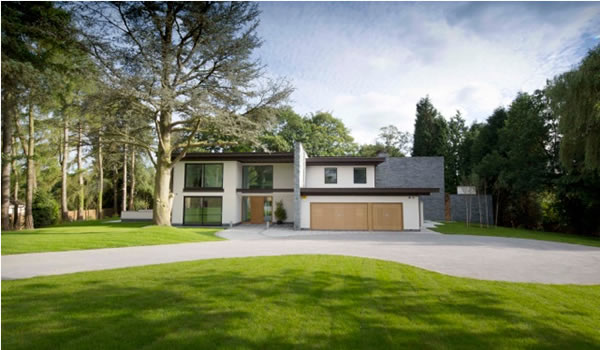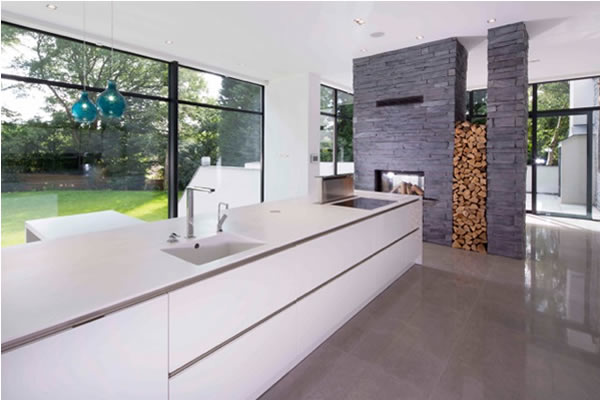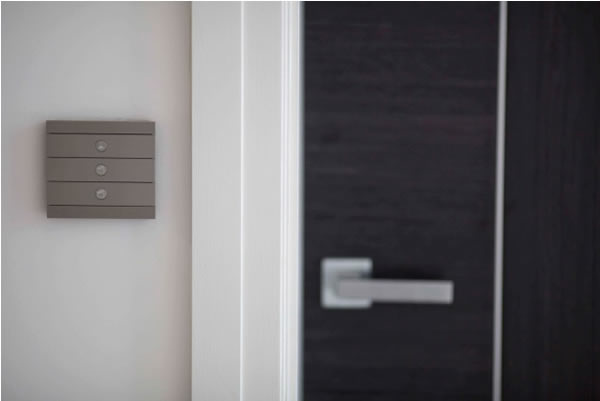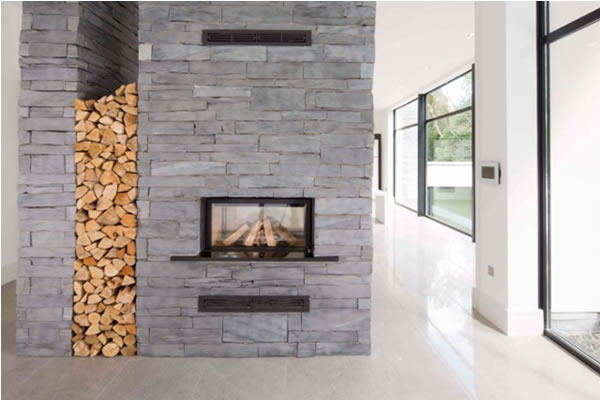 By Paul Murphy, Intecho UK.
By Paul Murphy, Intecho UK.
Intecho was commissioned to devise a home technology solution for Sleepy Hollow; a stunning, architect-designed and environmentally-friendly luxury home in the village of Prestbury, Cheshire.

The client – award winning property developer Hillcrest Homes – understood that the inclusion of a comprehensive home intelligence system was an essential element to the high-quality specification of the new home, and one that would deliver real benefit to the future owners.
A speculative build, which was recognised recently in The Sunday Times newspaper’s Top 50 Homes in the UK, Sleepy Hollow covers 10,000 sq ft and includes a number of renewable energy features which had to be controlled and monitored using a whole-house system. The project was completed in September 2012.
Planning and Design
Early engagement is essential during the planning process, so it is crucial that all parties are around the table from the outset. We were invited to join in discussions on Sleepy Hollow at an early stage, which allowed us to advise the client on the different types of technology that would complement both the fundamental design of the home, and the lifestyle of the buyer they were targeting.

As the project was speculative, we were able to recommend solutions based on our past experience with clients who own or have built homes within the multi-million pound property bracket. We were also able to provide ‘future proof’ solutions, allowing for any additional technology or modifications the owners may wish to install in years to come.
Once a consensus had been reached about the systems required and the main objectives, namely ease of use for the end-user and energy efficiency throughout, we could look at joining together the various components to be controlled as one seamlessly-integrated and intuitive system.
Our system of choice for the installation was KNX, the worldwide standard for home and building control. Superb for energy management and with an open protocol, it gave our design engineers access to over 7000 products from more than 300 companies, allowing them to select the best component for each task.

Installation
Throughout the building and installation process, we worked closely with Hillcrest’s electrical contractors and project manager, undertaking regular site inspections to supervise the installation.
The installation was carried out in two stages. The first fix cabling was installed by the electrical contractor, who was supervised and managed by us, and who had been issued detailed plans sufficient for any competent electrician to follow.
The second phase involved delivering our control panels that had been built off-site. Again, these were installed by the electrical contractor who would then connect all field cables and energise circuits once tested. Once this stage was completed, we could install the KNX devices, and carry out testing and commissioning of the system.
Time on site can vary depending on the size of the project, but a large, high-end residential property such as this would typically require a minimum of 7-10 days on site, including client handover.
Operation
With energy management being a priority for such a large property, the KNX system allowed internal and external lighting, underfloor heating and hot water to be controlled on a whole-house or room-by-room basis. The system is operated at the touch of a button, via touchscreen or remotely via an iPad, and is capable of reducing energy consumption by as much as 50%.

Ultimately, the system was designed to make living in the home as effortless as possible. The use of iPads was considered to be a desirable solution to controlling the system due to their portability and dual function as both a computer and a smart remote.
Experience from the Project
The planning at the beginning of the project really paid dividends. Energy consumption came out as expected, while the client was also extremely pleased with the ease of operation provided by the system, and in particular, with the ability to manage the whole property via a touchscreen controller in the kitchen, or from the sofa using a smartphone or tablet.
During the initial install, the property was pre-wired for future additions and expansion to allow for automated blinds throughout, along with additional music zones around the house. Now the homebuyer can also control all blinds or curtains around the home, and this has further enhanced energy efficiency by ensuring that focal windows can be automatically shaded during the summer, and curtains and blinds can be closed during the winter to retain heat.
Remote access has also been enabled, meaning that the homeowner can control lighting, heating and other systems whilst away on holiday or business.
Conclusion
The client was delighted with the results. Mike Kennedy, Managing Director at Hillcrest Homes, commented, “It was important that the property showcased the very best of what we have to offer whilst being equipped with eco-friendly functions tailored to meet the needs of the modern ‘environmentally conscious’ homeowner. Intecho was the obvious choice for us when looking to install such an advanced home technology system and they have absolutely delivered on every level.”
Sleepy Hollow was also chosen by The Sunday Times as ‘Best Designed’ in its Top 50 Homes in the UK 2013, and has been praised by local residents as ‘exciting and innovative.’
Equipment List
KNX components for lighting and heating controls from various manufacturers including ABB, Jung, Theben and Wago.
ABB PriON switches.
ABB ComfortTouch in-wall controller.
HDTV with 5.1 Dolby Surround Sound system with iPads as smart remotes.
Photovoltaic panels (to be installed).
Paul Murphy is Co-Founder and Director of Intecho, a leading provider of intelligent building technologies, home automation systems and audio-visual solutions for commercial and residential properties. The company has a reputation for designing bespoke solutions that incorporate technology into the fabric of a building, making living, working and playing effortless.












